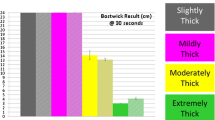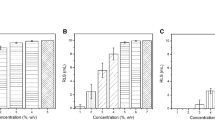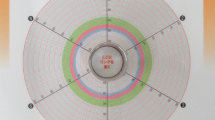Abstract
Although dietary modification is a common treatment strategy used to manage dysphagic patients who aspirate thin liquids, there are no standard definitions for thickened liquid preparation. This lack of standardization leads to variability in practice and points to the need for a simple tool for clinicians to assess thickened liquid consistency. The current study analyzed the utility of the Line Spread Test (LST) in this regard. Twenty-six liquids (10 powder-thickened “nectar” juices, 10 powder-thickened “honey” juices, and 6 barium mixtures) were assessed using both a viscometer for objective measurement of viscosity and the LST. Whereas the LST was able to separate the juices into nectar and honey categories, it was not able to separate barium mixtures into these categories nor compare barium to juices. Furthermore, the LST was not predictive of viscosity. Thus, the results of the current study suggest that the LST may be useful in the broad categorization of fluids into therapeutically significant groupings but that it cannot be used more specifically to measure fluid viscosity. Further studies of this and other tools are necessary to identify inexpensive practical tools for quantification of thickened liquid consistency.






Similar content being viewed by others
Notes
Conservation of fluid volume may be used to simply relate the slump height to the line spread distance, emphasizing the similarity between these two tests
References
Logemann J: Evaluation and Treatment of Swallowing Disorders. Austin, TX: Pro-Ed, 1998
Curran J, Groher M: Development and dissemination of an aspiration risk education diet. Dysphagia 5:6–12, 1990
Dervisoglu M, Kokini JL: Steady shear rheology and fluid mechanics of four semi-solid foods. J Food Sci 51(3):541–546, 1986
Pelletier C: A comparison of consistency and taste of five commercial thickeners. Dyphagia 12:74–78, 1997
Glassburn D, Deem J: Thickener viscosity in dysphagia management: Variability among speech-language pathologists. Dysphagia 13:218–222, 1998
Mann L, Wong K: Development of an objective method for assessing viscosity of formulated foods and beverages for the dysphagic diet. J Am Diet Assoc 96:585–588, 1996
Adams MC, Birdsall EL: New consistometer measures corn consistency. Food Industries 78–80, 1946
Grawemeyer EA, Pfund MC: Line spread as an objective test for consistency. Food Res 8:105–108, 1943
Logemann J, Gensler G, Robbins J, Lindblad AS, Brandt D, Hind JA, Kosek S, Dikeman K, Kazandjian M, Gramigna G, McGarvey-Toler S, Lundy D: A randomized study of three interventions for aspiration of thin liquids in patients with dementia or Parkinson’s disease. J Speech Lang Hear Res (in press) 2006
Brandt DK, Hind JA, Robbins JA, Lindblad AS, Gensler G, Gill G, Baum H, Lilienfeld D, Logeman JA: Randomized study of two interventions for liquid aspiration: short and long term effects. Clin Trails 3:457–468, 2006
Krieger IM, Maron SH: Direct determination of the flow curves of non-Newtonian fluids. J Appl Phys 23(1):147–149, 1952
Krieger IM, Elrod H: Direct determination of the flow curves of non-Newtonian fluids II. Shearing rate in the concentric cylinder viscometer. J Appl Phys 24(1):134–136, 1953
Yang TMT, Krieger IM: Comparison of methods for calculating shear rate in coaxial viscometers. J Rheol 22(4):413–421, 1978
Li M, Brasseur JG, Kem MK, Dodds WJ: Viscosity measurements of barium sulfate mixtures for use in motility studies of the pharynx and esophagus. Dyphagia 7:17–30, 1992
Steffe JF: Rheological Methods in Food Process Engineering. Lansing, MI: Freeman Press, 1996
Yang CS, Leong KC: Influences of substrate wettability and liquid viscosity on isothermal spreading of liquid droplets on solid surfaces. Exp Fluids 33:728–731, 2002
Pashias N, Boger DV: A fifty-cent rheometer for yield stress measurement. J Rheol 40(6):1179–1186, 1996
Scholwalter WR, Christensen G: Toward a rationalization of the slump test for fresh concrete: Comparisons of calculations and experiments. J Rheol 42(4):865–870, 1998
Coussot P: Mudflow rheology and dynamics. Rotterdam: A.A. Balkena, 1997
Hamlet S: Normal adult swallowing of liquid and viscous material: Scintigraphic data on bolus transit and oropharyngeal residues. Dysphagia 11:41–47, 1996
Dantas RO, Keern MK, Massey BT, Dodds WJ, Kahrilas PJ, Brasseur JG, Cook IJ, Lang IM: Effect of swallowed bolus variables on the oral and pharyngeal phases of swallowing. Am J Physiol 258:G675–G681, 1990
Miller J, Watkin KL: The influence of bolus volume and viscosity on anterior lingual force during the oral stage of swallowing. Dysphagia 11:117–124, 1996
Dantas RO, Dodds WJ, Massey BT, Kern MK: The effect of high- vs low-density barium preparations on the quantitative features of swallowing. AJR Am J Roentgenol 153:1191–1195, 1989
Sopade PA, Halley PJ, Cichero JAY, Ward LC: Rheological characterisation of food thickeners marketed in Australia in various media for the management of dysphagia. I: Water and cordial. J Food Eng 79:69–82, 2006
Acknowledgments
Special thanks to E-Z-EM, Inc. and Novartis Nutrition for providing materials used in this project.
Author information
Authors and Affiliations
Corresponding author
Additional information
This work was supported by the National Institutes of Health (U01 DC03206, R01 NS24427) and National Research Service Award (No. T32 AG00213) from the National Institute on Aging. This is GRECC manuscript 99-05.
Rights and permissions
About this article
Cite this article
Nicosia, M.A., Robbins, J. The Usefulness of the Line Spread Test as a Measure of Liquid Consistency. Dysphagia 22, 306–311 (2007). https://doi.org/10.1007/s00455-007-9086-3
Published:
Issue Date:
DOI: https://doi.org/10.1007/s00455-007-9086-3




